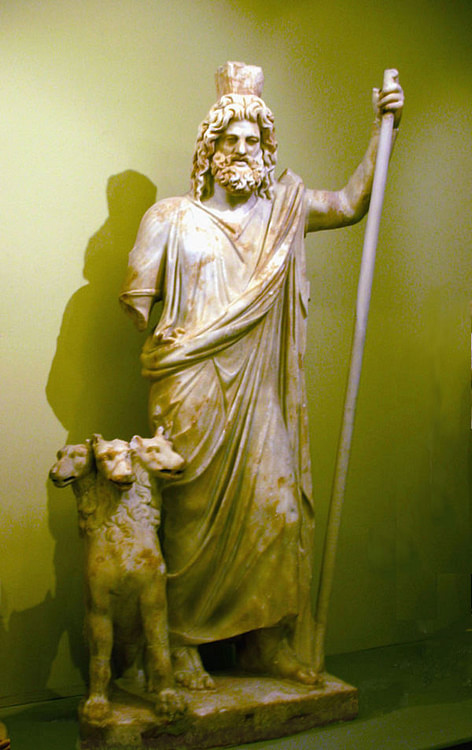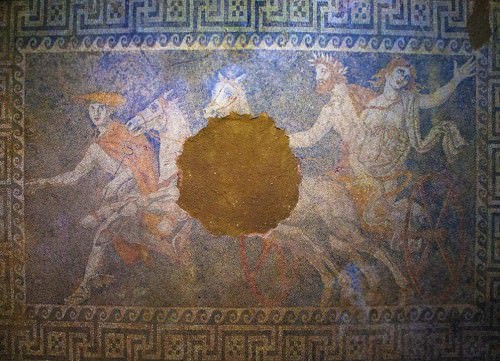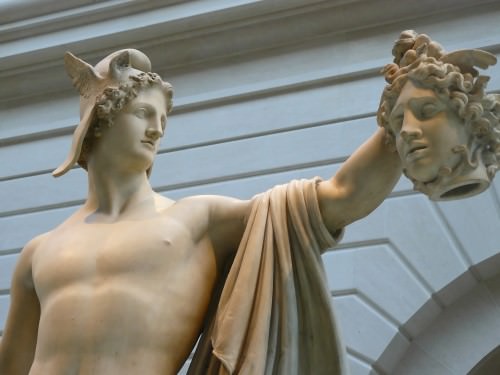Hades › Medusa » Ancient origins
Articles and Definitions › Contents
- Hades › Who Was
- Medusa › Who Was
Ancient civilizations › Historical and archaeological sites
Hades › Who Was
Definition and Origins

Hades was both the name of the ancient Greek god of the underworld ( Roman name: Pluto) and the name of the shadowy place below the earth which was considered the final destination for the souls of the dead. Perhaps the most feared of the gods, he is described by both Homer and Hesiod as 'pitiless', 'loathsome', and 'monstrous' Hades. The god's wife was Persephone whom he abducted to join him in the underworld, and his symbol is a sceptre or cornucopia.
HADES THE GOD
Following the overthrow of first the Titans and then the Giants by the Olympian gods, Hades drew lots with his brothers Zeusand Poseidon to decide which part of the world each would rule. Zeus received the sky, Poseidon the seas, and Hades the underworld. Perhaps a less prominent protagonist in the tales of mythology than the other Olympian gods, Hades, nevertheless, must have been held in superstitious awe by many ordinary Greeks. Indeed, even to speak his name was avoided; instead epithets were used such as Eubuleus (giving good advice). There are also accounts of sacrificial practices made in honour of Hades, carried out at night and where the blood of victims was left to seep down into the earth to reach the underworld god.
Hades was the only god not to reside on Mount Olympus, dwelling instead in a dark palace beneath the earth. The god also had a helmet made by Hephaistos which rendered the wearer invisible, and it was this helmet that was used by Athena when she fought Ares in Homer's account of the Trojan War in the Iliad and by Perseus in his quest for the head of Medusa.
HADES WAS THE ONLY GREEK GOD NOT TO RESIDE ON MOUNT OLYMPUS, DWELLING INSTEAD IN A DARK PALACE BENEATH THE EARTH.
In mythology, Hades fell in love with Persephone, daughter of Zeus and Demeter, and abducted her to live with him. When Hermes discovered this, he demanded Persephone be returned to Demeter and it was decided that if she had not eaten any food from Hades, she could return to the upper world. However, Hades tricked the girl into eating a pomegranate seed and therefore she could only return to the living for half of the year. This myth was symbolic perhaps of the cycle of life and death, planting and harvest. The celebration of Persephone's return to the upper world was probably a part of the famous Eleusian Mysteries performed at the sanctuary of Demeter at Eleusis.
In Archaic and Classical Greek art, Hades is most often represented as a more mature man, bearded and holding a sceptre, a two-pronged spear, a libation vase, or a cornucopia - symbolic of the mineral and vegetable wealth which comes from the ground. On occasion he is seated on an ebony throne or rides a chariot pulled by black horses, often with Persephone at his side.

Persephone Mosaic, Amphipolis
HADES THE UNDERWORLD
The god Hermes was believed to lead souls to the river Styx in the underworld, at which point the aged boatman Charon ferried them to the gates of Hades where Kerberos - the ferocious three-headed dog (or fifty-headed according to Hesiod) with serpents coming out of its body - stood guard to keep souls in rather than to keep others out. It was for payment to Charon that bereaved family members put a coin in the mouth of the deceased (for Greeks the traditional coin was the low-value obol).The unburied or those without the means to pay the boatman were condemned to wander the Earth as ghosts. This belief hints at the ambiguous nature of Hades. It was not necessarily a place of torment and suffering but in most cases, simply the final resting place of the soul.
On arrival at the gates of Hades, the final destination of the souls was determined by an assessment of their actions whilst they were alive. Traditionally, the three judges of souls were Minos, Rhadamanthys, and Aiakos, themselves noted for their honourable lives. Souls judged to have led especially good lives were first taken to drink the waters of the River Lethe which made them forget all bad things, and then they were taken to the idyllic Elysian Fields. Those souls judged to have led bad lives were put in the hands of the Furies and taken to Tartarus, the lowest level of Hades, to receive punishment for their misdeeds. The worst-offending souls, those who had offended the gods with their impiety, were condemned to eternal torment.Examples of those so punished were Sisyphus who had to forever roll a rock up a hill, Tantalos who could never quench his thirst, Oknos who plaits one end of a rope while a donkey eats the other end, the daughters of Danaus who had to try and fill a sieve with water, and Ixion who was tied to an ever-spinning wheel.

Persephone & Hades
Although a fearful place to the living, Hades was visited by several heroes in the course of their various adventures, including Hercules to capture Kerberos in the last of his twelve labours, by Odysseus to seek the advice of wise Tiresias, by Orpheusto find Eurydice, and by Theseus and Peirithoos to capture Persephone so that she might marry the latter. These last two heroes were, however, less fortunate than the others in that Hades imprisoned them in two thrones (or tied to two rocks in other accounts) and only Theseus would later escape from the underworld when Hercules released him.
Medusa › Who Was
Definition and Origins

Medusa was one of three sisters born to Phorcys and Ceto known as the Gorgons. According to Hesiod 's Theogony, the Gorgons were the sisters of the Graiai and lived in the utmost place towards the night by the Hesperides beyond Oceanus.Later authors such as Herodotus and Pausanias place the Gorgons' abode in Libya. The Gorgon sisters were Sthenno, Euryale, and Medusa; Medusa was mortal while her sisters were immortal.
Beyond the Gorgon's birth, there is little mention of the Gorgons as a group, but Medusa has several myths about her life and death. The most famous of these myths concern her death and demise. In Hesiod's Theogony, he recounts how Perseus cut off the head of Medusa and from her blood sprang Chrysaor and Pegasus, Chrysaor being a golden giant and Pegasus the famous white winged-horse.
PERSEUS & MEDUSA
The myth of Perseus and Medusa, according to Pindar and Apollodorus, started with a quest. Perseus was the son of Danae and Zeus, who came to Danae in the form of a golden spring. It was foretold to Danae's father, Acrisius the King of Argos, that Danae's son would kill him. So Acrisius locked his daughter away in a bronze chamber, but Zeus transformed into a shower of gold and impregnated her anyway. Acrisius, not wanting to provoke Zeus, hurled his daughter and grandson in a wooden chest into the sea. The mother and son were rescued by Dictys on the island of Seriphos. It was Dictys who raised Perseus to manhood, but it was Dictys' brother Polydectes, the king, who would send him on a life-threatening quest.
Polydectes fell in love with Perseus' mother and wished to marry her but Perseus was protective of his mother since he believed Polydectes to be dishonorable. Polydectes contrived to trick Perseus; he held a large banquet under the pretense of collecting contributions for the marriage of Hippodamia, who tamed horses. He requested that his guests bring horses for their gifts but Perseus did not have one. When Perseus confessed that he had no gift, he offered any gift the king would name.Polydectes seized his opportunity to disgrace and even get rid of Perseus and asked for the head of the only mortal Gorgon: Medusa.
MEDUSA WAS A FORMIDABLE FOE, SINCE HER HIDEOUS APPEARANCE WAS ABLE TO RENDER ANY ONLOOKER INTO STONE.
Medusa was a formidable foe, since her hideous appearance was able to render any onlooker into stone. In some variations of the myth, Medusa was born a monster like her sisters, described as girded with serpents, vibrating tongues, gnashing their teeth, having wings, brazen claws, and enormous teeth. In later myths (mainly in Ovid ) Medusa was the only Gorgon to possess snake locks, because they were a punishment from Athena. Accordingly, Ovid relates that the once beautiful mortal was punished by Athena with a hideous appearance and loathsome snakes for hair for having been raped in Athena's templeby Poseidon.
Perseus, with the aid of divine gifts, found the Gorgons' cave and slayed Medusa by beheading her. Most authors assert that Perseus was able to behead Medusa with a reflective bronze shield that Athena gave to him while the Gorgon slept. At the beheading of Medusa, Pegasus and Chrysaor (Poseidon's and her children) sprang from her severed neck. Simultaneously with the birth of these children, Medusa's sisters Euryale and Sthenno pursued Perseus. However, the gift bestowed upon him by Hades, the helmet of darkness, granted him invisibility. It is unclear if Perseus took Pegasus with him on his following adventures or if he continued to utilize the winged sandals Hermes gave him. Pegasus' adventures with both the hero Perseus and Bellerophon are classic tales from Greek mythology.

Medusa Mosaic
Perseus now flew (either by Pegasus or winged sandals) with Medusa's head safely bagged, ever potent with its stony gaze.Perseus, on his journey home, stopped at Ethiopia where the kingdom of King Cepheus and Queen Cassiopeia was being tormented by Poseidon's sea monster, Cetus. Poseidon's vengeance was being exacted on the kingdom for Cassiopeia's hubristic claim that her daughter, Andromeda, (or she herself) was equal in beauty to the Nereids. Perseus slew the beast and won Andromeda's hand. Andromeda was already betrothed, though, which caused a contestation to break out, resulting in Perseus using Medusa's head to turn her previous betrothed to stone.
Before his return to his home of Seriphos, Perseus met the titan Altas, who he turned to stone with Medusa's head after some quarrelsome words, thus creating the Atlas Mountains of North Africa. Also during the journey home, Medusa's head spilled some blood on the earth which formed into Libyan vipers that killed the Argonaut Mospos.
Perseus returned home to his mother, safe from King Polydectes' advances, but Perseus was infuriated with Polydectes' trickery. Perseus avenged himself by turning Polydectes and his court to stone with Medusa's head. He, then, gave the kingdom to Dictys. After Perseus was finished with the Gorgon's head, he gave it to Athena, who adorned her shield and breastplate with it.

Perseus & Medusa
ETYMOLOGY
The word Gorgon derives from the ancient Greek word "γοργός" meaning "fierce, terrible and grim." The Gorgons' names each have a particular meaning that helps to further describe their monstrousness. Sthenno from the ancient Greek "Σθεννω", is translated as "strength, might, or force," since it is related to the Greek word: σθένος. Euryale is from the ancient Greek "Ευρυαλη" meaning "broad, wide-stepping, wide threshing;"
€style however her name may also mean "of the wide briny sea." This would be an appropriate name since she is the daughter of ancient sea deities, Phorcys and Ceto. Medusa's name comes from the ancient Greek verb "μέδω" which is translated as "to guard or protect." Medusa's name is extremely fitting as it is synonymous with what a Gorgon's head became representative of on Athena's shield.
€style however her name may also mean "of the wide briny sea." This would be an appropriate name since she is the daughter of ancient sea deities, Phorcys and Ceto. Medusa's name comes from the ancient Greek verb "μέδω" which is translated as "to guard or protect." Medusa's name is extremely fitting as it is synonymous with what a Gorgon's head became representative of on Athena's shield.
REPRESENTATIONS IN ART
The Gorgon image appears in several pieces of art and architectural structures including the pediments of the Temple of Artemis (c. 580 BCE) in Corcya ( Corfu ), the mid-6th century BCE, larger-than-life marble statue (that is now in the archaeological museum of Paros ) and the celebrated cup by Douris. The Gorgon became a popular shield design in antiquity along with being an apotropaic (warding off evil) device. The goddess Athena and Zeus were often portrayed with a shield (or aegis) depicting the head of a Gorgon, who is typically believed to be Medusa.
There are also several archaeological examples of the Gorgon's face being used on breastplates, in mosaics and even as bronze end pieces on ship beams in the Roman period. Perhaps the most famous example of Medusa in art in antiquity was the Athena Parthenos statue from the Parthenon which was made by Phidias and described by Pausanias. This statue of Athena depicts a Gorgon's face on the goddess' breastplate. In Greek mythology there is, also, Hesiod's description of Hercules ' shield which describes the events of Perseus and Medusa.
LICENSE:
Article based on information obtained from these sources:with permission from the Website Ancient History Encyclopedia
Content is available under License Creative Commons: Attribution-NonCommercial-ShareAlike 3.0 Unported. CC-BY-NC-SA License